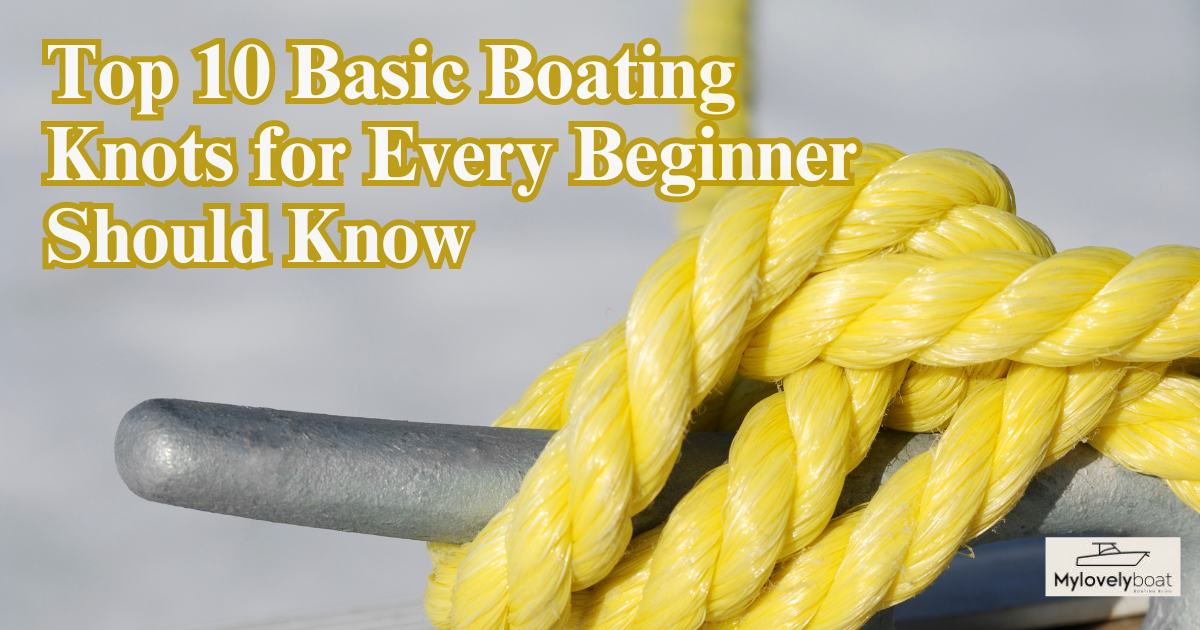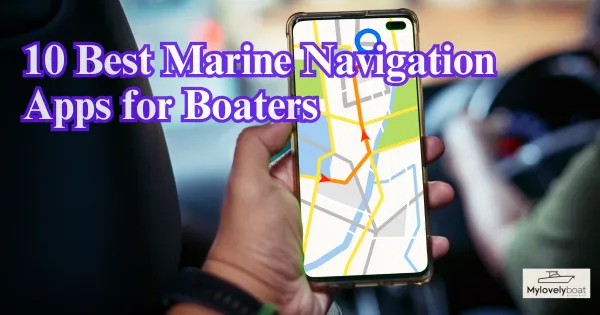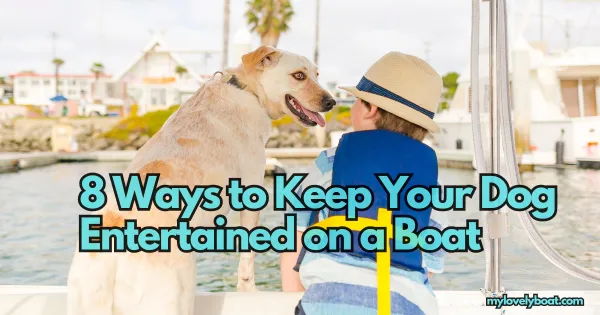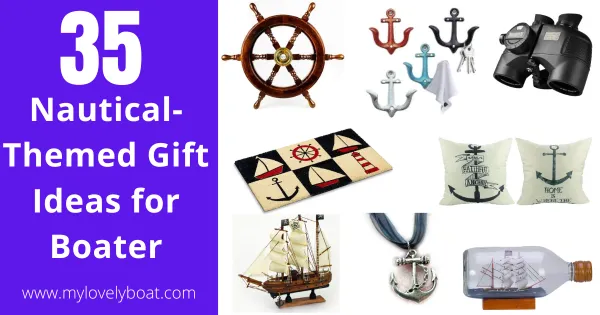
Boating requires mastering several skills, with knot tying topping the list.
Mastering the art of knot tying is fundamental for every boating enthusiast, from novices to seasoned sailors.
Knots are not just about securing your vessel; they’re about ensuring water safety, efficiency, and reliability.
This guide will introduce you to basic but crucial boating knots, catering especially to beginners looking to develop a solid foundation.
Here Is List of 10 Basic Boating Knots for Beginners
- Bowline
- Cleat Hitch
- Clove Hitch
- Half-Hitch (also call the Overhand Knot)
- Figure Eight
- Stopper Knot
- Sheet Bend
- Rolling Hitch
- Reef Knot/Square Knot
- Double Fisherman’s Knot
Bowline
The Quintessential Sailor’s Knot
- Purpose: To create a secure loop at a rope’s end that won’t slip or bind.
Step-by-Step Guide:
- Make a small loop (the rabbit hole) in the standing part of the rope.
- Bring the end up through the loop (the rabbit comes out of the hole), around the standing part (behind the tree), and back down through the loop (back into the hole).
- Tighten by pulling on the standing part while holding the loop.
This loop is essential for mooring and rescue lines, as it’s easy to untie, even after being subjected to a heavy load.
Cleat Hitch
For Docking
- Purpose: Securely tie a rope to a cleat, typically found on docks.
Step-by-Step Guide:
- Loop rope around the base of the cleat, then over the top and around the opposite horn.
- Make a figure-eight pattern around the cleat’s horns.
- Finish by making an underhand loop and slipping it over a cleat horn to lock.
Ideal for docking, as it provides a firm hold and is quick to tie and release.
Clove Hitch
Quick and Effective
- Purpose: Attach a rope to a post, pole, or another rope.
Step-by-Step Guide:
- Wrap the rope around the object.
- Cross over the standing part and wrap again.
- Tuck the end under the last wrap and pull to secure.
Great for temporary mooring and securing fenders to a boat.
Half-Hitch (or Overhand Knot)
Building Block Knot
- Purpose: A simple knot used on its own or as part of other knots.
Step-by-Step Guide:
- Pass the end of the rope around an object or the standing part of another knot.
- Bring the end up and through the loop created.
Often used in pairs (Double Half Hitch) for added security.
Figure Eight Knot
Prevents Rope from Slipping
- Purpose: Create a stop at the end of a rope to prevent it from sliding through a retainer.
Step-by-Step Guide:
- Make a loop.
- Cross the end behind the standing part.
- Bring the end through the loop.
Ideal for climbers and boaters alike, serving as a reliable stopper.
Stopper Knot
General-Purpose Stopper
- Purpose: Prevents the rope’s end from fraying or passing through a hole.
A common version of this is the Figure Eight knot mentioned above, serving the same purpose with easy tying steps.
Sheet Bend
Joining Two Ropes
- Purpose: Efficiently connect two ropes of different sizes or rigidity.
Step-by-Step Guide:
- Form a bight with the larger or stiffer rope.
- Pass the end of the other rope through the bight from behind.
- Wrap it around both parts of the bight then tuck it under itself.
Stronger than a Square Knot and easier to untie after being strained.
Rolling Hitch
For Strain Relief
- Purpose: Tie a rope to a pole or another rope that’s under load.
Step-by-Step Guide:
- Wrap the rope around the object at least twice.
- Add one or two more wraps in the same direction but slightly looser.
- Tuck the end under the last wrap and pull tight.
Ideal for relieving tension on another rope or redirecting the load.
Reef Knot (Square Knot)
Joining Ends
- Purpose: Tie two ends of a single rope to secure something closed, like a sail around a boom.
Step-by-Step Guide:
- Tie a Left-over-Right Half-Knot.
- Follow it with a Right-over-Left Half-Knot.
- Pull tight to secure.
Not recommended for joining two ropes together, especially under load, as it can easily come undone.
Double Fisherman’s Knot
For High-Strength Joining
- Purpose: Securely join two ropes, particularly suitable for heavy loads.
Step-by-Step Guide:
- Tie a loose overhand knot at the end of one rope, using the end of another rope.
- Repeat in the opposite direction with the other end around the first rope.
- Pull both standing ends to slide the knots together.
This knot forms a strong, reliable bond between two ropes, often used in climber’s rigging.
Additional Tips
Knot Maintenance and Safety: Regularly inspect your ropes and knots for signs of wear and tear. Practice tying knots in different conditions to build muscle memory.
Common Mistakes to Avoid: Overcomplicating knots can lead to failure when it’s most critical. Learn to tie each knot properly before moving to the next.
How to Practice and Improve: Create a routine. Practice tying and untying each knot. Use various types and thicknesses of ropes to adapt to different scenarios.
FAQ-
- How do you tie a basic boat knot?
To tie a basic boat knot, such as the Square Knot (also known as a Reef Knot), follow these steps:
- Take two ends of your rope.
- Pass the right end over and under the left end.
- Then pass the left end over and under the right.
- Pull both ends to tighten the knot.
- What knot is used to tie up a boat?
The most common knot for tying up a boat to a dock is the Cleat Hitch. Here’s how to tie it:
- Pass the rope around the base of the cleat closest to the boat.
- Make a figure-eight pattern around the cleat horns.
- Form an underhand loop with the free end.
- Slip the loop over the cleat horn and pull tightly to secure it.
- What knots should every marine know?
Every mariner should know these critical knots:
- Bowline Knot: This is used to create a strong loop at the end of a rope.
- Cleat Hitch: For docking and securing the rope to the cleat.
- Clove Hitch: For attaching a line quickly to a post.
- Rolling Hitch: For attaching a rope to another rope.
- Figure Eight Knot: For preventing a rope end from slipping through a retaining device.
- What are the different basic knots to tie?
Different basic knots include:
- Square Knot: For joining two ends of a single line.
- Sheet Bend: This is for joining two ropes of different sizes.
- Two Half Hitches: For securing a rope around an object.
- Bowline: For creating a fixed loop at the end of a rope.
- Clove Hitch: For attaching the rope to an object.
- What is the strongest knot?
The Double Fisherman’s Knot is considered one of the strongest knots for joining two ropes. It’s extremely reliable under tension and used by climbers for safety. - How do you tie a perfect boat?
The term ‘perfect boat’ isn’t a standard terminology for a knot, but for securing a boat, tying a secure Cleat Hitch is one of the best methods:
- Wrap the rope’s end around the base of the cleat.
- Cross it over to make a figure-eight around both horns of the cleat.
- Tuck a loop under the last cross to make it fast.
- What is the most secure boat knot?
The Bowline is renowned for its strength and security. It creates a fixed loop that does not slip or bind and can be untied easily after being under load.





